Experimental Study on Strength and Microstructure of Glacial Till Stabilized by Ionic Soil Stabilizer
Abstract
:1. Introduction
2. Materials and Methods
2.1. Materials
2.1.1. F1 Ionic Soil Stabilizer
2.1.2. Glacial Till
2.1.3. Sample Preparation
2.2. Methods
2.2.1. Physical Properties Tests
2.2.2. Mechanical Properties Tests
2.2.3. Microstructure Tests
3. Results
3.1. Effects of F1 on Atterberg Limits
3.2. Effects of F1 on Maximum Dry Density and Optimum Moisture Content
3.3. Effects of F1 on CBR
3.4. Effects of F1 on UCS
3.5. Microstructural Analysis
4. Discussion
4.1. Strong Cation Exchange
4.2. Hydrophobic Interaction
5. Conclusions
- F1 can reduce the liquid limit, plastic limit, plastic index, and optimum moisture content of the glacial till and increase the maximum dry density of the glacial till, which significantly improves the water sensitivity and compaction characteristics of the glacial till.
- F1 can significantly increase the CBR and UCS of the glacial till and effectively restrain its swelling deformation. 0.35 L/m3 is the optimum concentration of F1 for stabilizing glacial till. Compared with the natural glacial till, the stabilized soil with an F1 concentration of 0.35 L/m3 increases the CBR by 108.6%, and the UCS increases by 102.1%.
- F1 can accumulate the fine particles and needle-like particles of the glacial till into large particles in the form of flakes and agglomerates, which significantly reduces the porosity and pore sizes of the glacial till, thereby increasing the compactness of the glacial till. F1 can reduce the interplanar spacing of the glacial till, and the mineral composition does not change during the stabilization process.
- F1 can destroy the diffuse double layer structure on the surface of glacial till particles and reduce the thickness of the adsorbed water layer through strong cation exchange and hydrophobic interactions of active sulfonated oil, which reduce the spacing of glacial till particles, enhance the aggregation of glacial till particles. After the F1 stabilized soil was compacted, the soil particles formed a layered stacking structure with more compact arrangements and larger agglomerates, enhancing the compactness of the glacial till.
- Compared with lime, cement, and other traditional soil stabilizers, F1 has many advantages, such as simple construction, low cost, short maintenance period, and environmental friendliness. Therefore, it has broad application prospects in soil improvement and road construction in glacial till areas.
Author Contributions
Funding
Informed Consent Statement
Data Availability Statement
Conflicts of Interest
References
- Tang, L.; Li, G.; Li, Z.; Jin, L.; Yang, G. Shear properties and pore structure characteristics of soil–rock mixture under freeze–thaw cycles. Bull. Eng. Geol. Environ. 2021, 80, 3233–3249. [Google Scholar] [CrossRef]
- Zhang, Y.; Tie, Y.; Wang, L.; Liu, J. CT Scanning of Structural Characteristics of Glacial Till in Moxi River Basin, Sichuan Province. Appl. Sci. 2022, 12, 3040. [Google Scholar] [CrossRef]
- Tu, G.X.; Huang, R.Q.; Deng, H.; Li, Y.R. Sedimentary Characteristics of the Pleistocene Outwash Accumulation and their Implications for Paleoclimate Change in the Midstream of Dadu River, Southwestern China. Acta Geol. Sin.-Engl. 2012, 86, 924–931. [Google Scholar] [CrossRef]
- Wang, S.N.; Shi, C.; Xu, W.Y.; Wang, H.L.; Zhu, Q.Z. Numerical direct shear tests for outwash deposits with random structure and composition. Granul. Matter 2014, 16, 771–783. [Google Scholar] [CrossRef]
- Xie, Y.; Zhang, C.; Yang, J.; Chen, B.; Fu, J.; Zhu, Z. Study on failure characteristics and reinforcement measures of surrounding rock of glacial deposit tunnels based on coarse-grained DEM. Chin. J. Rock Mech. Eng. 2021, 40, 576–589. [Google Scholar] [CrossRef]
- Latifi, N.; Eisazadeh, A.; Marto, A.; Meehan, C.L. Tropical residual soil stabilization: A powder form material for increasing soil strength. Constr. Build. Mater. 2017, 147, 827–836. [Google Scholar] [CrossRef]
- Ghadir, P.; Zamanian, M.; Mahbubi-Motlagh, N.; Saberian, M.; Li, J.; Ranjbar, N. Shear strength and life cycle assessment of volcanic ash-based geopolymer and cement stabilized soil: A comparative study. Transp. Geotech. 2021, 31, 100639. [Google Scholar] [CrossRef]
- Miturski, M.; Gluchowski, A.; Sas, W. Influence of Dispersed Reinforcement on Mechanical Properties of Stabilized Soil. Materials 2021, 14, 5982. [Google Scholar] [CrossRef]
- Miturski, M.; Sas, W.; Radzevicius, A.; Sadzevicius, R.; Skominas, R.; Stelmaszczyk, M.; Gluchowski, A. Effect of Dispersed Reinforcement on Ultrasonic Pulse Velocity in Stabilized Soil. Materials 2021, 14, 6951. [Google Scholar] [CrossRef]
- Pu, S.; Zhu, Z.; Huo, W. Evaluation of engineering properties and environmental effect of recycled gypsum stabilized soil in geotechnical engineering: A comprehensive review. Resour. Conserv. Recycl. 2021, 174, 105780. [Google Scholar] [CrossRef]
- Gu, J.; Lyu, H.; Yang, J.; Zeng, C. Effects of cement content and curing period on geotechnical properties of cement-treated calcareous sands. Transp. Geotech. 2022, 33, 100732. [Google Scholar] [CrossRef]
- Ikhlef, N.-S.; Ghembaza, M.S.; Dadouch, M. Effect of Treatment with Cement on the Mechanical Characteristics of Silt from Telagh Region of Sidi Belabes, Algeria. Geotech. Geol. Eng. 2015, 33, 1067–1079. [Google Scholar] [CrossRef]
- Pu, S.; Zhu, Z.; Zhao, L.; Song, W.; Wan, Y.; Huo, W.; Wang, H.; Yao, K.; Hu, L. Microstructural properties and compressive strength of lime or/and cement solidified silt: A multi-scale study. Bull. Eng. Geol. Environ. 2020, 79, 5141–5159. [Google Scholar] [CrossRef]
- Han, L.; Li, J.; Xue, Q.; Chen, Z.; Zhou, Y.; Poon, C.S. Bacterial-induced mineralization (BIM) for soil solidification and heavy metal stabilization: A critical review. Sci. Total Environ. 2020, 746, 140967. [Google Scholar] [CrossRef]
- Li, Y.; Li, J.; Cui, J.; Shan, Y.; Niu, Y. Experimental study on calcium carbide residue as a combined activator for coal gangue geopolymer and feasibility for soil stabilization. Constr. Build. Mater. 2021, 312, 125465. [Google Scholar] [CrossRef]
- Wang, D.; Zhu, J.; He, F. CO2 carbonation-induced improvement in strength and microstructure of reactive MgO-CaO-fly ash-solidified soils. Constr. Build. Mater. 2019, 229, 116914. [Google Scholar] [CrossRef]
- Liu, J.; Chen, Z.; Kanungo, D.P.; Song, Z.; Bai, Y.; Wang, Y.; Li, D.; Qian, W. Topsoil reinforcement of sandy slope for preventing erosion using water-based polyurethane soil stabilizer. Eng. Geol. 2019, 252, 125–135. [Google Scholar] [CrossRef]
- Yang, S.; Liu, W. The Effect of Changing Fly Ash Content on the Modulus of Compression of Stabilized Soil. Materials 2019, 12, 2925. [Google Scholar] [CrossRef]
- Ma, C.; Zhao, B.; Long, G.; Sang, X.; Xie, Y. Quantitative study on strength development of earth-based construction prepared by organic clay and high-efficiency soil stabilizer. Constr. Build. Mater. 2018, 174, 520–528. [Google Scholar] [CrossRef]
- Wu, Y.; Shi, K.; Yu, J.; Han, T.; Li, D. Research on Strength Degradation of Soil Solidified by Steel Slag Powder and Cement in Seawater Erosion. J. Mater. Civ. Eng. 2020, 32, 04020181. [Google Scholar] [CrossRef]
- Wang, S.; Li, X.; Ren, K.; Liu, C. Experimental Research on Steel slag Stabilized Soil and its Application in Subgrade Engineering. Geotech. Geol. Eng. 2020, 38, 4603–4615. [Google Scholar] [CrossRef]
- Ojuri, O.O.; Adavi, A.A.; Oluwatuyi, O.E. Geotechnical and environmental evaluation of lime–cement stabilized soil–mine tailing mixtures for highway construction. Transp. Geotech. 2017, 10, 1–12. [Google Scholar] [CrossRef]
- Zhou, S.-Q.; Zhou, D.-W.; Zhang, Y.-F.; Wang, W.-J.; Li, D. Research on the Dynamic Mechanical Properties and Energy Dissipation of Expansive Soil Stabilized by Fly Ash and Lime. Adv. Mater. Sci. Eng. 2019, 2019, 5809657. [Google Scholar] [CrossRef]
- Inazumi, S.; Intui, S.; Jotisankasa, A.; Chaiprakaikeow, S.; Shinsaka, T. Applicability of mixed solidification material based on inorganic waste as soil stabilizer. Case Stud. Constr. Mater. 2020, 12, e00305. [Google Scholar] [CrossRef]
- Suo, C.; Fang, P.; Cao, H.; Cao, J.; Liu, K.; Dong, X. Influence and microscopic mechanism of the solid waste-mixture on solidification of Cu2+-contaminated soil. Constr. Build. Mater. 2021, 305, 124651. [Google Scholar] [CrossRef]
- He, J.; Shi, X.-K.; Li, Z.-X.; Zhang, L.; Feng, X.-Y.; Zhou, L.-R. Strength properties of dredged soil at high water content treated with soda residue, carbide slag, and ground granulated blast furnace slag. Constr. Build. Mater. 2020, 242, 118126. [Google Scholar] [CrossRef]
- Yoobanpot, N.; Jamsawang, P.; Horpibulsuk, S. Strength behavior and microstructural characteristics of soft clay stabilized with cement kiln dust and fly ash residue. Appl. Clay Sci. 2017, 141, 146–156. [Google Scholar] [CrossRef]
- Katz, L.E.; Rauch, A.F.; Liljestrand, H.M.; Harmon, J.S.; Shaw, K.S.; Albers, H. Mechanisms of Soil Stabilization with Liquid Ionic Stabilizer. Transp. Res. Rec. : J. Transp. Res. Board 2001, 1757, 50–57. [Google Scholar] [CrossRef]
- Hu, R.; Wang, X.; Liu, H.; Leng, H. Scour Protection of Submarine Pipelines Using Ionic Soil Stabilizer Solidified Soil. J. Mar. Sci. Eng. 2022, 10, 76. [Google Scholar] [CrossRef]
- Rauch, A.F.; Harmon, J.S.; Katz, L.E.; Liljestrand, H.M. Measured Effects of Liquid Soil Stabilizers on Engineering Properties of Clay. Transp. Res. Rec. J. Transp. Res. Board 2002, 1787, 33–41. [Google Scholar] [CrossRef]
- Wu, X.-T.; Qi, Y.; Liu, J.-N.; Chen, B. Solidification Effect and Mechanism of Marine Muck Treated with Ionic Soil Stabilizer and Cement. Minerals 2021, 11, 1268. [Google Scholar] [CrossRef]
- Al-Dakheeli, H.; Arefin, S.; Bulut, R.; Little, D. Effectiveness of ionic stabilization in the mitigation of soil volume change behavior. Transp. Geotech. 2021, 29, 100573. [Google Scholar] [CrossRef]
- Tingle, J.S.; Newman, J.K.; Larson, S.L.; Weiss, C.A.; Rushing, J.F. Stabilization Mechanisms of Nontraditional Additives. Transp. Res. Rec. J. Transp. Res. Board 2007, 1989-2, 59–67. [Google Scholar] [CrossRef]
- Wu, X.-T.; Qi, Y.; Chen, B. Solidification effect and mechanism of ionic soil stabilizer applied on high-water-content clay. Bull. Eng. Geol. Environ. 2021, 80, 8583–8595. [Google Scholar] [CrossRef]
- Lu, X.; Luo, J.; Wan, M.; Zhou, G. Optimization of Ionic Soil Stabilizer Dilution and Understanding the Mechanism in Red Clay Treatment. Adv. Civ. Eng. 2021, 2021, 5749863. [Google Scholar] [CrossRef]
- Lu, X.S.; Wei, X. Experimental Study on Ionic Soil Stabilizer Reinforcing Red Clay. Adv. Mater. Res. 2011, 183–185, 1736–1740. [Google Scholar] [CrossRef]
- Lu, X.S.; Xiang, W. Study on Ionic Soil Stabilizer Reinforcing Red Clay of Wuhan. Adv. Mater. Res. 2011, 261–263, 1129–1133. [Google Scholar] [CrossRef]
- Lu, X.S.; Xiang, W. Experimental Study on Dynamic Characteristics of Ionic Soil Stabilizer Reinforcing Red Clay. Adv. Mater. Res. 2011, 374–377, 1391–1395. [Google Scholar] [CrossRef]
- Xiang, W.; Cui, D.; Liu, Q.; Lu, X.; Cao, L. Theory and practice of ionic soil stabilizer reinforcing special clay. J. Earth Sci. 2010, 21, 882–887. [Google Scholar] [CrossRef]
- Zhang, Z.; Zhang, J.; Zhang, H. Effects and Mechanisms of Ionic Soil Stabilizers on Warm Frozen Soil. Arab. J. Sci. Eng. 2018, 43, 5657–5666. [Google Scholar] [CrossRef]
- Zhang, Z.; Zhang, H.; Zhang, J.; Chai, M. Effectiveness of Ionic Polymer Soil Stabilizers on Warm Frozen Soil. KSCE J. Civ. Eng. 2019, 23, 2867–2876. [Google Scholar] [CrossRef]
- Huang, W.; Zhang, Y.; Luo, Z.; Wei, X.; Fu, H. Reduction of Clay Hydration by Addition of an Organic Stabilizer. Clays Clay Miner. 2021, 69, 489–499. [Google Scholar] [CrossRef]
- Huang, W.; Feng, Z.; Fu, H.; Xiang, W.; Hua, M. Evolution of Pore Characteristics for Bentonite Modified by an Ionic Soil Stabilizer during Hydration Processes. Adsorpt. Sci. Technol. 2021, 2021, 7777091. [Google Scholar] [CrossRef]
- Wu, X.-T.; Sun, J.-S.; Qi, Y.; Chen, B. Pore and compression characteristics of clay solidified by ionic soil stabilizer. Bull. Eng. Geol. Environ. 2021, 80, 5003–5019. [Google Scholar] [CrossRef]
- He, S.; Yu, X.; Banerjee, A.; Puppala, A.J. Expansive Soil Treatment with Liquid Ionic Soil Stabilizer. Transp. Res. Rec. J. Transp. Res. Board 2018, 2672, 185–194. [Google Scholar] [CrossRef]
- Arefin, S.; Al-Dakheeli, H.; Bulut, R. Stabilization of expansive soils using ionic stabilizer. Bull. Eng. Geol. Environ. 2021, 80, 4025–4033. [Google Scholar] [CrossRef]
- Li, J.-D.; Wang, X.; Zhang, Y.-J.; Jiang, D.-J.; Liu, D.-R.; Wang, J.-L. Study on strength characteristics and mechanism of loess stabilized by F1 ionic soil stabilizer. Arab. J. Geosci. 2021, 14, 1162. [Google Scholar] [CrossRef]
- Sun, P.; Zhu, J.; Zhao, B.; Zhang, X.; Cao, H.; Tian, M.; Han, M.; Liu, W. Study on the Mechanism of Ionic Stabilizers on Shale Gas Reservoir Mechanics in Northwestern Hunan. Energies 2019, 12, 2453. [Google Scholar] [CrossRef]
- Lin, Z.-X.; Liu, L.-M.; Liu, L.-W. Validation of the solidifying soil process using laser-induced breakdown spectroscopy. Opt. Laser Technol. 2016, 83, 13–15. [Google Scholar] [CrossRef]
- Gautam, S.; Hoyos, L.R.; He, S.; Prabakar, S.; Yu, X. Chemical Treatment of a Highly Expansive Clay Using a Liquid Ionic Soil Stabilizer. Geotech. Geol. Eng. 2020, 38, 4981–4993. [Google Scholar] [CrossRef]
- JTG 3430-2020. Test Methods of Soils for Highway Engineering; People’s Communications Press: Beijing, China, 2020. (In Chinese) [Google Scholar]
- Li, G.-Y.; Hou, X.; Mu, Y.-H.; Ma, W.; Wang, F.; Zhou, Y.; Mao, Y.-C. Engineering properties of loess stabilized by a type of eco-material, calcium lignosulfonate. Arab. J. Geosci. 2019, 12, 700. [Google Scholar] [CrossRef]
- Zhao, H.; Ge, L.; Petry, T.M.; Sun, Y.-Z. Effects of chemical stabilizers on an expansive clay. KSCE J. Civ. Eng. 2013, 18, 1009–1017. [Google Scholar] [CrossRef]


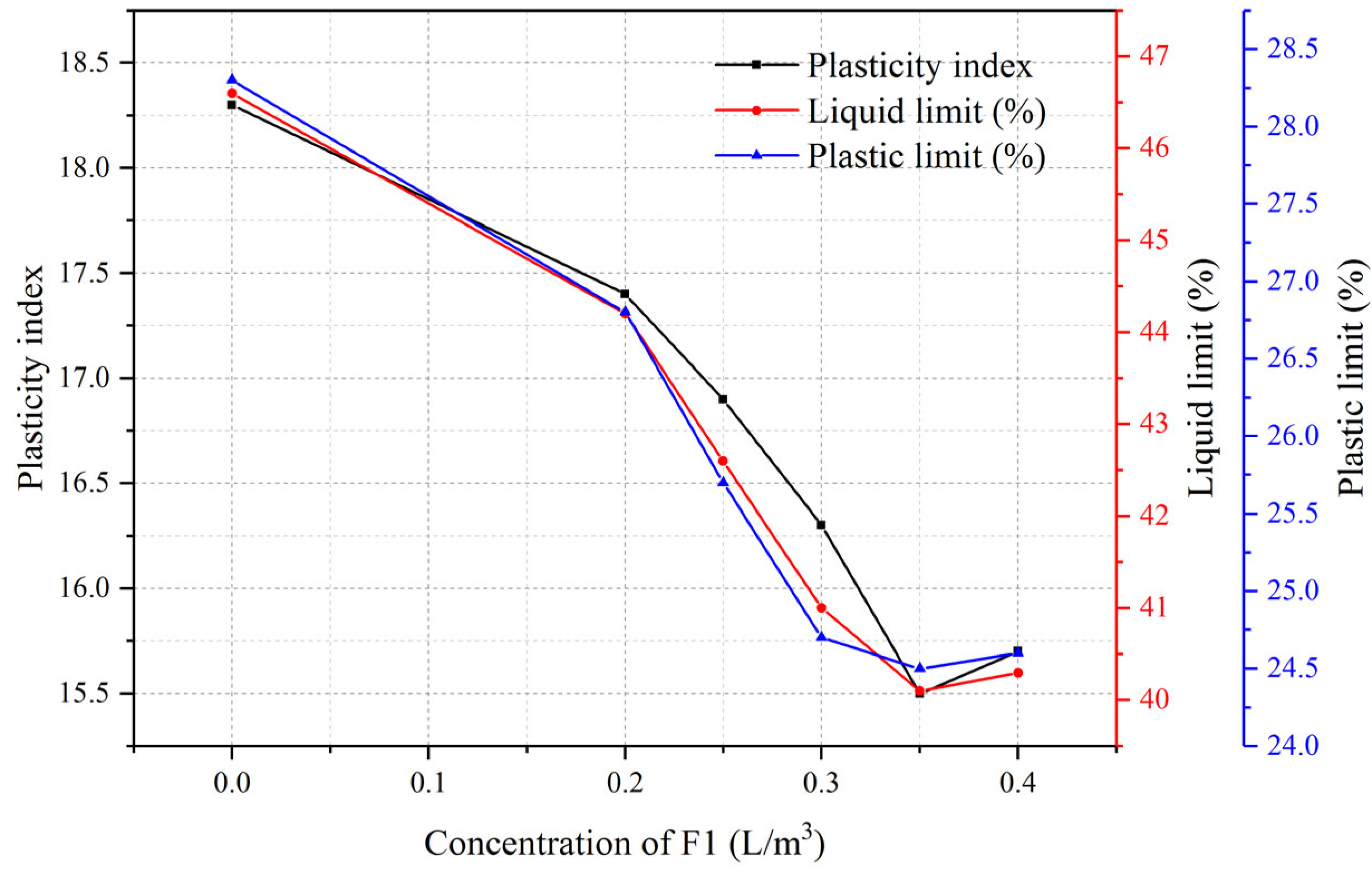


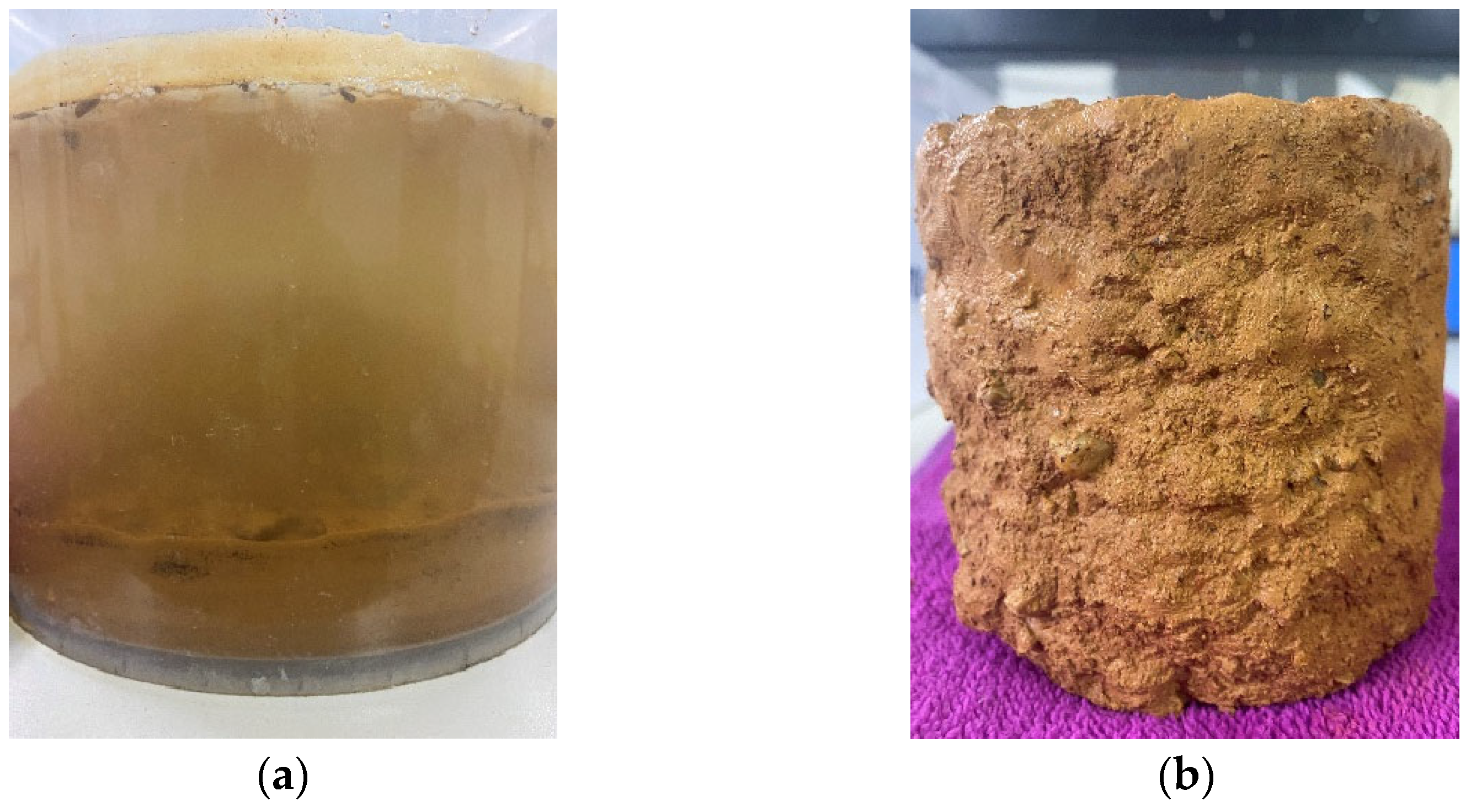

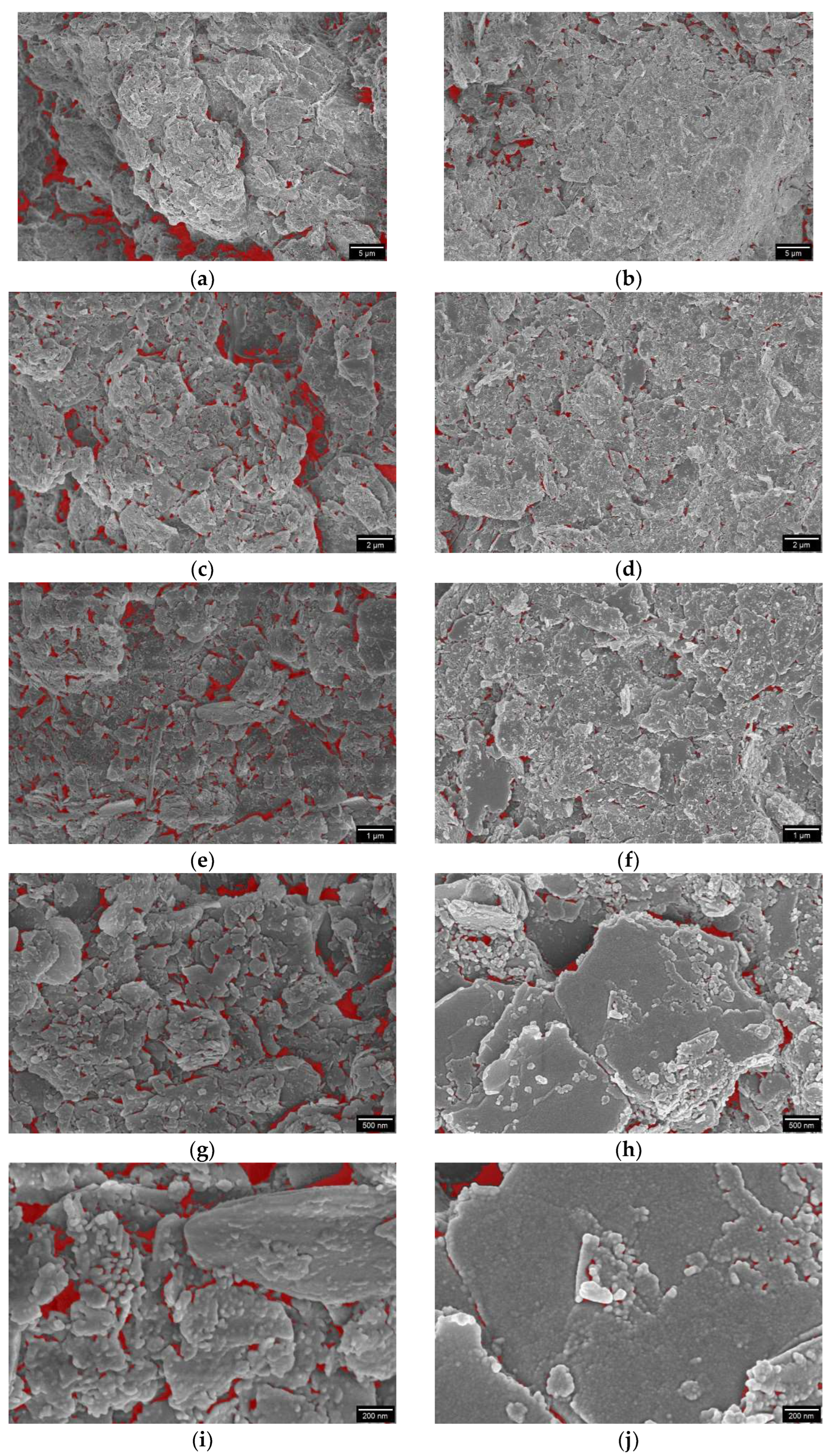
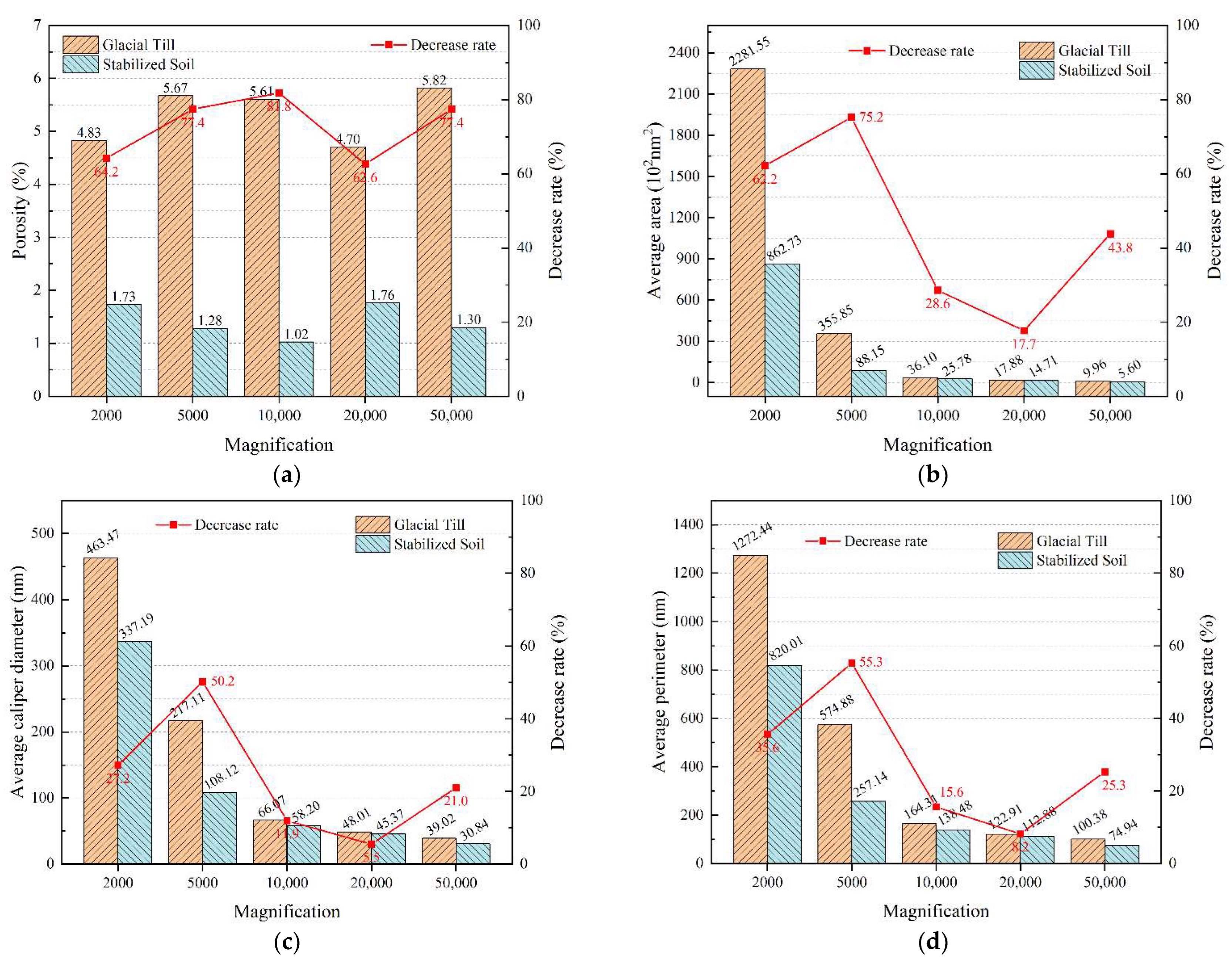

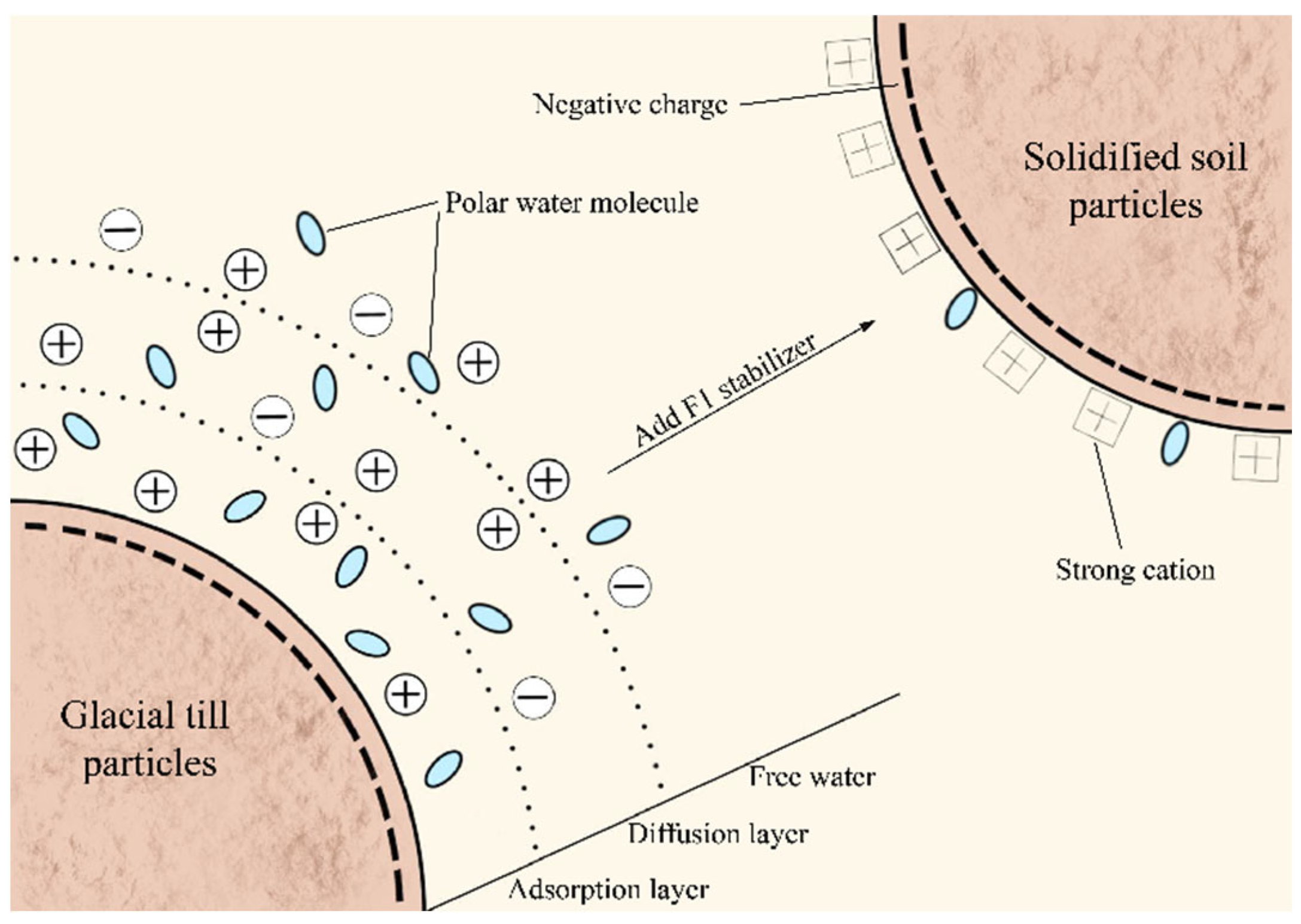
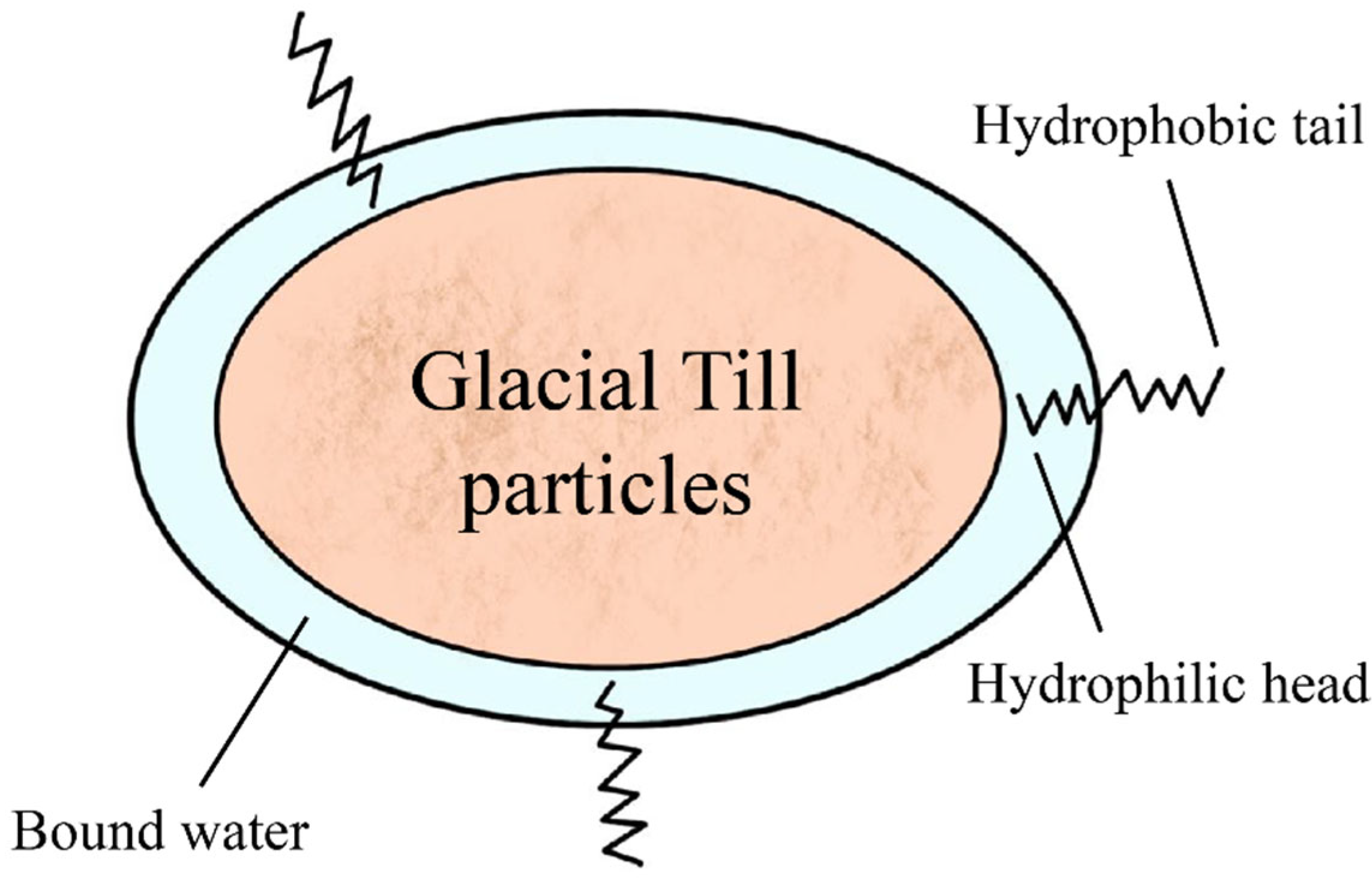
| Effective Grain Size (mm) | Median Grain Size (mm) | Constrained Grain Size (mm) | Coefficient of Uniformity | Coefficient of Curvature |
|---|---|---|---|---|
| 0.21 | 0.88 | 6.0 | 28.57 | 0.61 |
| Concentration of F1 (L/m3) | Maximum Dry Density (g/cm3) | Optimum Moisture Content (%) |
|---|---|---|
| 0 | 1.69 | 18.6 |
| 0.2 | 1.76 | 17.8 |
| 0.25 | 1.78 | 17.4 |
| 0.30 | 1.82 | 16.5 |
| 0.35 | 1.85 | 15.1 |
| 0.40 | 1.83 | 15.6 |
| 2θ (Degree) | Interplanar Spacing (nm) | |
|---|---|---|
| Glacial Till | Stabilized Soil | |
| 20 | 4.4712 | 4.4625 |
| 40 | 2.2373 | 2.2361 |
| 60 | 1.5420 | 1.5414 |
Publisher’s Note: MDPI stays neutral with regard to jurisdictional claims in published maps and institutional affiliations. |
© 2022 by the authors. Licensee MDPI, Basel, Switzerland. This article is an open access article distributed under the terms and conditions of the Creative Commons Attribution (CC BY) license (https://creativecommons.org/licenses/by/4.0/).
Share and Cite
Huang, Y.; Fan, W.; Wu, J.; Xiang, X.; Wang, G. Experimental Study on Strength and Microstructure of Glacial Till Stabilized by Ionic Soil Stabilizer. Buildings 2022, 12, 1446. https://doi.org/10.3390/buildings12091446
Huang Y, Fan W, Wu J, Xiang X, Wang G. Experimental Study on Strength and Microstructure of Glacial Till Stabilized by Ionic Soil Stabilizer. Buildings. 2022; 12(9):1446. https://doi.org/10.3390/buildings12091446
Chicago/Turabian StyleHuang, Yifan, Wenfeng Fan, Jinliang Wu, Xinglong Xiang, and Guan Wang. 2022. "Experimental Study on Strength and Microstructure of Glacial Till Stabilized by Ionic Soil Stabilizer" Buildings 12, no. 9: 1446. https://doi.org/10.3390/buildings12091446





